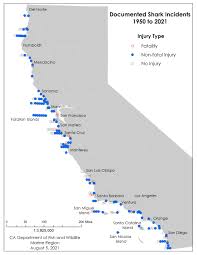A man was bitten in the thigh while surfing with friends at Salmon Creek Beach Sunday morning. Fellow surfers helped him to safety ashore before first responders took the surfer, in his 30s, to a nearby hospital. The man identified only as Eric was observed thrashing and struggling and calling for help as other surfers paddled over. The surfers quickly applied a tourniquet form a surfboard leash and helped the victim ashore. He was airlifted to a Santa Rosa hospital where his injuries to his legs are considered serious but he is expected to survive.
Located near a rivermouth and haul out for pinnipeds and near the foraging grounds for seals and sealions, Salmon Creek is a hot spot for white shark activity. The unidentified man makes the 5th confirmed white shark encounter at Salmon Creek since scientists began researching these events.
Salmon Creek Recorded Shark Encounters
May 2019 surfer Katie Wilson encountered what is believed to be a shark while paddling out to catch her first wave. Wilson was 100 yards offshore of North Salmon Creek Beach when the shark caught her surfboard leash in its mouth. The shark was reported as a white shark visible by its dorsal fin and tail. The shark allowed the unharmed Wilson to escape and paddle ashore.
At around 9:45 Am on November 22, 2002 Michael Casey, was the first shark attack victim to have been recorded at Salmon Creek. The 48 year old Casey was severely bitten in the legs while body boarding at Salmon Creek but survived with injuries.
On May 28, 2004 Bernard ‘Butch’ Connor, Jr. was bitten at North Salmon beach while surfing around 11 Am. The shark, and estimated 14 to 18 foot great white shark bumped him, thrashing its tail and head, and repeatedly circled him.
On Oct. 19, 2005, Megan Halavais received severe lacerations when a 14-foot shark bit her leg and pulled her underwater. Halavais, 20, was surfing off Salmon Creek Beach in Sonoma County when the shark attacked her from behind.
The Shark Research Committee, part of the Shark Research Institute investigates and records shark -human encounters. Since 2000, the Shark Research Committee lists 116 incidents between sharks and humans in California, this being the 117th. In that period 6 were fatal, all associated with white sharks. This makes an average of a confirmed white shark bump or bite at around 5.6 incidents or one fatality every 4 years over the past 21.
Sharks have much more to be afraid of humans than we do of them. For roughly every recorded shark attack in the world, human beings kill about 1.45 million sharks. (About 100 million sharks are killed each year mostly for their cartilaginous fins; there have been 69 shark attacks documented this year; 7 of those incidents later proved fatal and 5 attacks were provoked.)
Scientists believe these events are a case of mistaken identity. White sharks are ambush predators on marine mammals such as elephant seals, harbor seals and seal lions. A swimmer,, body boarder or a surfer appear like their prey when seen from below. White sharks generally rush their prey from below or behind and typically bite, spit and circle. In most cases, the sharks do not re-engage and the victim survives a white shark attack if given aid quickly enough.
Most of these encounters with humans occur in the fall months we call Sharktober, and over half of all deaths occur in what is known as The Red Triangle.

The last fatality in California was recorded May of 2020, by what is believed to be a great white 10 to 12 feet long fatally bit 26-year-old surfer Ben Kelly was surfing at Manresa Beach, just south of Santa Cruz.
A study published by Stanford scientists in 2015 found that surfers have about a 1-in-17 million risk of being attacked by a great white shark off California ,the species responsible for 176 of the 198 shark “incidents” recorded by the California Department of Fish and Wildlife.
By comparison, the annual risk of being killed from drowning by ocean-goers are 1,817 times more likely than dying from a shark attack.
Most serious human encounters with white sharks occur in California during the late summer and early fall, when mature great white sharks return form an offshore migration to forage along the west coast. These months during the months we call Sharktober is the period of peak observations of seal predations wounds on seals and human interactions.